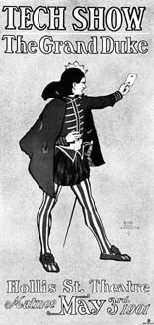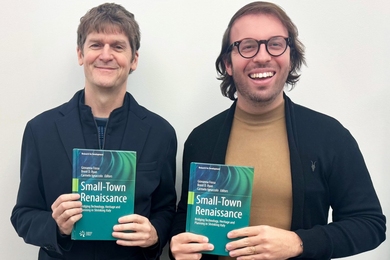The year was 1901. Carrie Nation was beginning her axe-wielding anti-alcohol crusade, Guglielmo Marconi transmitted the first transatlantic radio signals, President William McKinley was assassinated and the first Nobel Prizes were awarded.
On the MIT campus, then located in Boston, the Department of Ocean Engineering created a special course on warship design and the Department of Physics prepared to launch a separate Department of Electrical Engineering. And the men of MIT presented the American premiere of Gilbert and Sullivan's final collaboration -- The Grand Duke.
The distinction of offering the American premiere of the operetta was called "no small feather in the theatrical cap of Tech" by MIT's student newspaper, the Tech. MIT President Henry S. Pritchett announced that on "two afternoons... the exercises at the Institute will be suspended to allow all students to attend the Tech play."
This weekend, the MIT Gilbert and Sullivan Players (MITG&SP) will present the 100th anniversary production of The Grand Duke, a rarely produced operetta by the famous English duo of librettist and poet Sir William Schwenck Gilbert (1836-1911) and composer Sir Arthur Seymour Sullivan (1842-1900).
The MIT production will look notably different from the 1901 premiere, in part because of the dramatic changes in MIT demographics. In 1901, the MIT student population was still predominantly male and the cast was composed entirely of men, in both male and female roles. The 2001 cast is split evenly between male and female students with no cross-gendered principle roles.
The original cast was also nearly three times as large as the current cast: there was a whopping total of 64 men in the 1901 cast, and the number swelled to nearly 100 with extra dancers and a large chorus. The current cast totals 34.
Another difference in the two productions is the venue. In 1901 the show was performed in Boston's Hollis Street Theater, an opulently gilded Victorian facility (demolished in 1935) that seated more than 1,600. Its stage -- 51 feet deep and 73 feet wide -- must have been more than adequate for the large 1901 cast. In contrast, the current production will be in La Sala de Puerto Rico, where students will construct a platform stage and set up chairs for an audience of 150-180.
Also, in 1901, the MIT men concluded their show with a final "grand ballet," which the Boston Globe described as follows: "Twenty-four students, clad in the college colors of red and gray, appeared upon the stage and rapidly formed the letters 'MIT.' Then the dance proper began, and for 10 minutes the students went through with a whirlwind piece of work that would show well against the achievements of any professionals. It brought out tempestuous applause, and when the dancers began it for the second time they were greeted from all over the theatre by rousing Tech cheers and college yells."
The current production won't include anything like that, said first-time director Dave Jedlinsky (SB 1989) with a laugh, though he said the dance moves do include an energetic can-can performed by 24 cast members. "It's not the final dance, nor does it last 10 minutes -- for which the cast is very thankful."
The 1901 production was the Institute's third Tech Show, a tradition which originated in 1899 and continued through 1936. Usually an original student-written musical revue or vaudeville comedy, the Tech Show was revived in 1947, when women first joined the cast, and continued through 1969. MIT's Musical Theatre Guild has presented Tech Shows sporadically since 1979.
"We are commemorating the US premiere of The Grand Duke, performed by undergraduates of MIT," said Mr. Jedlinsky, who was one of the founding members of MITG&SP in 1988. "We are not... the same group that did it the first time."
In homage to the initial MIT production of The Grand Duke, Mr. Jedlinsky has moved the operetta's 1750 setting to 1901. The plot -- a typically topsy-turvy Gilbert and Sullivan pastiche -- involves the complications that ensue when Ludwig, an actor, replaces the miserly Grand Duke of Pfennig Halbfennig after "killing" him in a statutory duel fought by drawing cards. In assuming the duke's obligations, Ludwig soon finds himself with far too many wives and prospective wives.
Both the Tech and the Boston Globe reviewed the 1901 production, and offered surprisingly different opinions of the show.
"Technology Students Give an Excellent Show" proclaimed the May 4, 1901 headline for the Globe review, a lengthy feature story on the MIT production that praised its every aspect. "It was at times hardly possible to believe that one was attending a performance given by amateurs," wrote the reviewer.
The Tech's review of their peers was more severe, criticizing diction, stage presence, dropped lines and voices which they described as "not especially pleasing."
"At almost every turn the melody is either smooth or brilliant, showing here and there a newness and originality that rises to a point of marked excellence," the Globe said.
But the Tech criticized the music. "The music was not as catchy as last year's," said the writer, daring to unfavorably compare Sir Arthur Sullivan's compositions with those presumably written by an MIT undergraduate. "One does not hear snatches of it sung or whistled about Tech as was the case at that time."
The 2001 production of The Grand Duke will be performed May 3-5 at 8pm and May 5-6 at 2pm in La Sala de Puerto Rico. Tickets are $9, $7 for MIT affiliates and senior citizens, and $6 for students. For more information or reservations, call x3-0190, send e-mail or go to MITG&SP web site.
A version of this article appeared in MIT Tech Talk on May 2, 2001.






